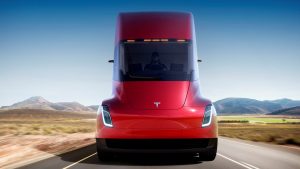Truck electrification a realty?
With the total cost of electric-vehicle ownership for some commercial applications already beating out internal-combustion engines, ACT Research predicts that electrification of the Class 4-8 commercial vehicle market in the U.S. and Canada will top 40 percent by 2040 — with a third of the market migrating to battery-electric solutions in the next 10 years.
For a follow-up to its 2018 report on commercial vehicle electrification, which predicted electric Class 4-7 truck sales could top 100,000 by 2035, ACT Research put together a comprehensive total cost of ownership analysis covering 14 sub-segments and 23 applications.

Truck Electrification A Realty – ACT Research predicts that electrification of the Class 4-8 commercial vehicle market in the U.S. and Canada will top 40 percent by 2040
The resulting report, “Charging Forward 2020-2040 BEV and FCEV Forecast and Analysis,’’ predicts 317,000 electric Class 4-8 vehicles by 2040.
“We think electrification is a reality,” said ACT analyst and economist Jim Meil. “Certainly a reality over the course of the 20-year time span, where we anticipate that across the Class 4 through 8 space, the market share migration from internal combustion engine to an electric power-train of one kind or another will be upwards of 40 percent of the available market. That translates into over 300,000 vehicles.
“And a lot of that progress we think is going to be made in the next 10 years. So you don’t have to wait till 2035 or 2040 to realize that. We think a lot of the traction is going to be gained between now and 2031.”
Enjoying our insights?
Subscribe to our newsletter to keep up with the latest industry trends and developments.
Stay InformedEven when it did its 2018 study, he said, “We were pretty optimistic.” Three years later, “fleet operators grasp this as a more tangible reality.”

Truck Electrification A Realty – …market share migration from internal combustion engine to an electric power-train of one kind or another will be upwards of 40 percent of the available market
The TCO analysis is vital, Meil said, because what drives commercial fleets to buy electric vehicles is very different from what drives consumers.
“When it comes to the personal vehicle, there’s a certain status that gets conveyed by having a Tesla and being the first on the block to have it, and the neighbors come over and look, or you impress your colleagues in the faculty lounge,’’ he said. “Those kind of, say, psychographics, don’t work in the ROI-driven, hard-nut financials of fleet operations.”
In fact, ACT’s findings show that for most Class 4-8 commercial vehicle operations, the total cost of ownership for electric vehicles is already below that for internal-combustion vehicles.
For example, for Class 6-7 box trucks in a local delivery application, ACT finds electric vehicles already have a 12-percent advantage. That advantage is expected to jump to 23 percent in 2027 as new regulations limiting NOx emissions are anticipated to kick in.
But fleet operators are risk-averse and need “proof cases,” so they prefer the “first mover” to be someone else, according to ACT’s report.
ACT sees an even higher penetration of electrification in the medium-duty market than overall, Meil said.

Truck Electrification A Realty – …total Class 4-8 share is expected to be around 42% in 20 years and 34% in 10 years, in the Class 6-7 marketplace… 70% share in that 20-year horizon, and in the next 10 years, almost 60 %
While the total Class 4-8 share is expected to be around 42 percent in 20 years and 34 percent in 10 years, in the Class 6-7 marketplace, ACT sees a 70-percent share in that 20-year horizon, and in the next 10 years, almost 60 percent.
There are several factors that ACT considers where electric vehicles can reap the most benefit:
- Low-speed, frequent-stop duty cycles, generally in high urban-density environments, which enables the benefit of regenerative braking.
- Intermediate miles per day – something on the order of 120 miles a day, high enough to achieve fuel-savings benefits, but low enough to avoid range anxiety.
- Return to base daily, which expedites charging
- Relatively low-cost infrastructure requirements.
Meil singles out two types of markets where ACT predicts electrification will see big gains in the coming years.
One is those with potential for high volume, such as Class 4-7 conventional trucks, Class 4 and 5 low-cab-forward trucks, Class 8 day cabs, and Class 6 and 7 school buses.
The other area is markets that may not be as high volume, but where ACT sees an especially high adoption rate – where the transition to electrification could be close to 100 percent% within the next 20 years. These include low-cab-forward medium-duty trucks, transit buses, step vans, school buses, and yard spotters.
For example, he said, “Class 8 yard spotters is a small volume market, it’s a niche market. But the mission requirements are so conducive to electrification, that we see almost a full migration for yard spotters.”
Truck Electrification A Realty – What isn’t going to electrify anytime soon? …Class 8 OTR applications, especially long-haul.
What isn’t going to electrify anytime soon? It’s pretty obvious, he said: Class 8 over-the-road applications, especially long-haul. These applications, Meil said, “sort of work the opposite way of those tendencies to electrify,” with high mileage, random routing, not doing start-and-stop, and not returning to base for easy charging.’’
(from HDT Trucking Info)




















